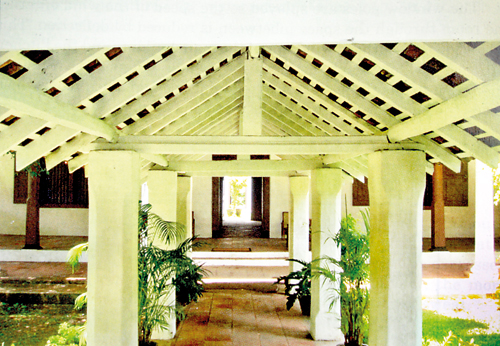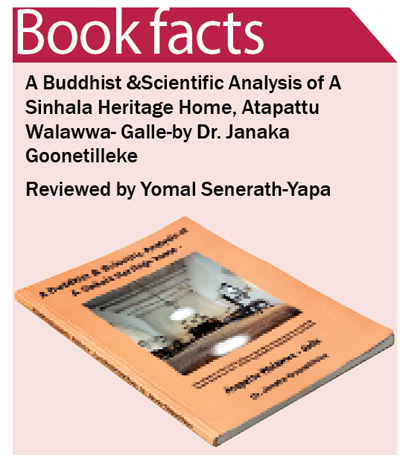The walawwa, where spirituality meets architecture
View(s): The walawwa may seem to be a symbol of a feudal past- conjuring images of a musty if grand manor-house, home to a haughty nobility who flourished on the labour of peasants. Yet this image leaves out much of the story. The walawwa- whether Kandyan or colonial- is really an invaluable part of our inheritance, and often made the perfect model habitation for our climes. It may have delighted in borrowings from the Portuguese, the Dutch and the English at times, but at heart, it embodied traditional knowledge and wisdom.
The walawwa may seem to be a symbol of a feudal past- conjuring images of a musty if grand manor-house, home to a haughty nobility who flourished on the labour of peasants. Yet this image leaves out much of the story. The walawwa- whether Kandyan or colonial- is really an invaluable part of our inheritance, and often made the perfect model habitation for our climes. It may have delighted in borrowings from the Portuguese, the Dutch and the English at times, but at heart, it embodied traditional knowledge and wisdom.
Dr. Janaka Goonetilleke, whose wife grew up in the halls and gardens of the Atapattu Walawwa in Galle, has done much to bring to light this mansion, whose oldest wings date back to the late 18th Century. In his new volume, the retired consultant gynaecologist takes us on a salubrious tour through the walawwa- divesting the manor of the imperial and the imperious- uncovering instead the invaluable native wisdom and the serene Buddhist ideals which shaped the breezy living rooms, the inner courtyard, the gardens: in fact the entire property.
The book deals with how the Sinhalese Buddhist home has, over the millennia, evolved into an abode that ensures “the development of intellect and freedom of mind, by encouraging relaxation”. In other words, the architecture and the lived-in experience the house offers are a conduit to achieving the final Buddhist goal- Nirvana.
The book brings to the fore Buddhist teaching, neuroscience, psychology and other branches of modern science. The first part explores how the brain is stimulated by the Buddhist home- whose prototype is the deeply shady Bo tree which helped the Buddha attain Enlightenment with its protection and unique relaxing properties. The second part- which is equally fascinating- analyzes incisively all aspects of the Sinhala heritage home from Buddhist and scientific viewpoints which converge. Though the language may want some salt and style, the author evokes how each of the five senses are soothed and protected within the house.
To pluck off just one example- when it comes to the overall visual design, ‘peripheral vision’ is favoured over ‘focused vision’. The interior and exterior of the walawwa are made up of repetitive patterns- so the centre of the eye (the fovea) does not get tired trying to focus on different individual objects. Instead, the rods and extra fovea (around the centre of the eye) can take in the repetitive details: the eternal pattern of clay tiles on the roof, or the soothing double verandah with its repetitive patterns of terracotta tiles, wooden pillars, rafters and beams- leaving the mind unoccupied and relaxed because single, stark objects do not clamour for attention- instead the eye takes in the harmonious patterns effortlessly. This kind of design is close imitation of nature- because all nature is repetitive pattern. The other four senses too are relaxed by blending architecture harmoniously with nature, and the book delves deep into how this happens.
 From the ventilation to the design of clay tiles and the social spaces, then the ergonomics of traditional furniture, and the role played by the trees in the garden and the herbs in the kitchen garden- it is an engrossing read. The text and pictures make you feel a deep thirst and nostalgia for this mansion- for every part of the house soothes the senses- the bedrooms with partial darkness, the cool terracotta tiles, the verandahs deeply shaded looking out to the gardens, the inner courtyard around which domestic life revolves.
From the ventilation to the design of clay tiles and the social spaces, then the ergonomics of traditional furniture, and the role played by the trees in the garden and the herbs in the kitchen garden- it is an engrossing read. The text and pictures make you feel a deep thirst and nostalgia for this mansion- for every part of the house soothes the senses- the bedrooms with partial darkness, the cool terracotta tiles, the verandahs deeply shaded looking out to the gardens, the inner courtyard around which domestic life revolves.
Protected and shaded physically and emotionally, in this setting you are in eternal peace with the world. Stress-free, relaxed and with a sense of harmony and inter-connectedness with nature, one can progress from here to the Buddhist ‘obliteration of self’ or Nirvana: to become “not a separate entity but part of the universe, like a water droplet in the depths of a lake.” The author explains that “(this) is the state of mind that made the Buddha engage with the environment and enable him to communicate with all sentient beings.”
Apart from the spiritual realm, modern architecture too has a lot to imbibe from this book. Reading, you stumble upon fundamentals cherished by Geoffrey Bawa. For example the traditional “externalization of internal space and internalization of the exterior”- explained here- was what the great tropical modernist did when he brought the garden indoors, and made the wild landscape outside a series of “outdoor rooms”- as we see at Lunuganga. But many more lessons remain to be imparted from this work.
The volume, though slim, cohesively binds together the elements of a very defined philosophy that is enshrined in the traditional Sinhala home. It is fascinating in showing the scientific explanations behind Buddhist ideas and in manifesting how architecture can lead to ultimate spiritual wellbeing. Dr. Goonetilleke, with his sophisticated western education and his experience of Sinhala peasant culture- garnered when working as a young relief MO in the villages of Rajarata- has penned an insightful work on a fascinating realm of knowledge. It will act as a trigger for more interest and research.


